PS4 – we test Sony's latest games at E3
After
some hands-on time at the games expo, here is our verdict on Killzone:
Shadow Fall; Driveclub; Knack and InFamous: Second Son – as well as the
Dual Shock 4 controller.
Slick presentations are all very well, but can hide a multitude of
sins – there's no substitute for getting your hands on a game in order
to gauge its merits. Currently, exact details of precisely which games will be available when the PlayStation 4 goes on sale remain unknown, but at least we managed to get some hands-on time with several of Sony's key first-party titles for the new console.
Killzone: Shadow Fall
Killzone is a slightly odd franchise: Guerrilla's first-person shooter has never quite hit the heights necessary to inspire the devotion afforded to the likes of Halo, but it has always been a solid performer. But Killzone: Shadow Fall, we reckon, is going to be the key PS4 launch title – the one that everyone will buy (unless they have an inescapable aversion to first-person shooters). Luckily, it's also the most impressive of the handful of Sony's PS4 launch titles that were playable at E3.For starters, it looks great, with incredible draw-distances and notably detailed (and therefore convincing) environments. And it doesn't look much like Killzones of yore – Guerrilla has finally ditched the gloomy black, brown and grey colour palette in favour of something rather more colourful, and lashings of lens-flare. Even though it is a PS4 launch title, it's sufficiently gorgeous to impress anyone who sees you playing it.
We played through a huge, sprawling open-world level, in which there were several specified objectives that you could take on however you preferred. We started behind Helghast lines, at the top of a cliff, looking down on a forest in which a pall of smoke indicated a downed aircraft which we had to reach; another objective involved disabling anti-aircraft turrets.
The game eschewed any form of being ushered down a specific path. Playing as a Shadow Marshal, we had a bunch of useful abilities, accessible by swiping the Dual Shock 4's touch-pad to the left or right, or up and down. One of which was a zip-line, which can attach to any surface (as long as it's below where you currently are). Other toys included the OWL drone, which can be sent to take on enemies – it will cope with one, but two or more will destroy it, but you can use it to engage enemies while you outflank them. And it can be sent to hack alarm pads, which Helghast would trigger when under attack, bringing in reinforcements by drop-ship.
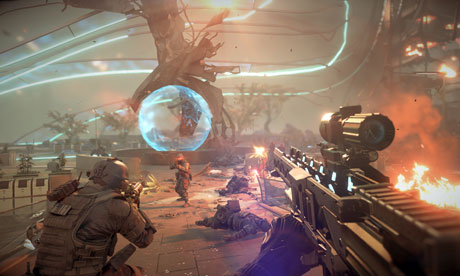 In classic Killzone style, you can also generate a shield to stand
behind (this time around, not tied to a particular gun). Our light
machine-gun had an alternate sniper-fire mode, and in tricky situations
(using the D-pad), we could launch an adrenaline burst, temporarily
slowing down time. A sonar sensor could be employed to scope out
concealed nearby enemies.
In classic Killzone style, you can also generate a shield to stand
behind (this time around, not tied to a particular gun). Our light
machine-gun had an alternate sniper-fire mode, and in tricky situations
(using the D-pad), we could launch an adrenaline burst, temporarily
slowing down time. A sonar sensor could be employed to scope out
concealed nearby enemies.That bristling array of gadgetry was pretty much essential – Killzone: Shadow Fall is pretty hard, with rigorous enemy AI (if they get close, they shine lights in your eyes, more or less blinding you, so you can't remain static), and in the level we played, employing stealth (followed by a neck-snapping takedown) was essential, as was deploying the OWL drone to keep enemies occupied. The control system's feel was superb, with great precision and just the right amount of snap, and visually, we found ourselves taking things slowly just because the scenery was so sumptuous. We climbed what was definitely the most realistic-looking rock face in any game.
There's no doubt whatsoever that Shadow Fall will be, by some considerable distance, the best Killzone game ever —playing it induced far more frissons of excitement than any of its predecessors. Of course, at this stage we can't say whether its storyline will live up to the visuals and the gameplay, but if you buy a PS4, it should be the first Sony-published game you buy.
Dual Shock 4
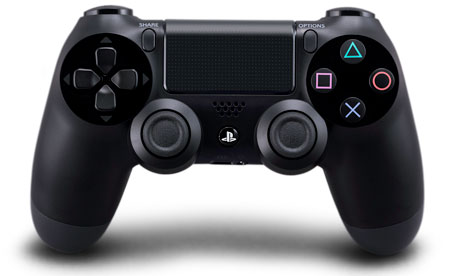 PlayStation 4 Dual Shock 4 controller: Sony's best yet
The PlayStation 4's
Dual Shock 4 controller may look like its similarly named predecessors,
but it has received a major and very thoughtful overhaul. The first
thing you notice about it is that the hand-grips are much longer than
those of previous Dual Shocks – which is great, especially for those
with larger hands. It instantly feels great to grip.
PlayStation 4 Dual Shock 4 controller: Sony's best yet
The PlayStation 4's
Dual Shock 4 controller may look like its similarly named predecessors,
but it has received a major and very thoughtful overhaul. The first
thing you notice about it is that the hand-grips are much longer than
those of previous Dual Shocks – which is great, especially for those
with larger hands. It instantly feels great to grip.The analogue sticks are a tiny bit stiffer than previously, but still move slickly, and the two sets of triggers for each hand are far more naturally placed than previously. But the biggest change to the controller is the touch-pad, which can also tilt slightly in any direction. In effect – as seen in Killzone: Shadow Fall – it can operate like a sort of mouse, and it offers all sorts of possibilities for developers – it supports multi-touch, so can read specific gestures. One notable absence on the controller is the Start button, whose responsibilities have devolved to the touch-pad. Force-feedback is impressive, too, thanks to the presence of two motors, one in each grip. The Dual Shock 4 is by far the best controller Sony has ever designed.
Driveclub
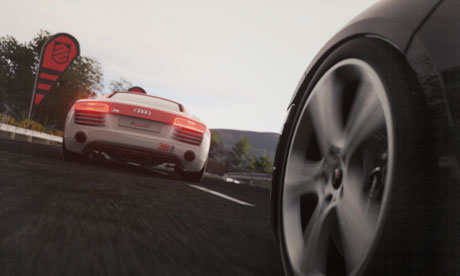 Driveclub: geared up for social play
Runcorn-based driving game developer Evolution Studios has a great
track record – in recent years, it has been responsible for the Motor
Storm games. But the demo of its PS4 launch title, Driveclub, which we
played at E3 left us thinking that the jury will remain out until we can
scrutinise a more complete version of the game.
Driveclub: geared up for social play
Runcorn-based driving game developer Evolution Studios has a great
track record – in recent years, it has been responsible for the Motor
Storm games. But the demo of its PS4 launch title, Driveclub, which we
played at E3 left us thinking that the jury will remain out until we can
scrutinise a more complete version of the game.It consisted of one track – a custom-designed effort in countryside surroundings – and four cars, including the Audi R8 V10, Pagani Huayra and McLaren MP4-12C. There was a glimpse of its social networking-style attributes on show, in the form of mini-challenges that you encountered at various parts of the track (average speed, cornering tidiness and drifting), in which you faced off against another car – the PS4 pods at the show were networked up to each other. You would either win or lose points for your Drive Club, and everything was totted up at the end of the race. The game also used the PS4 camera to take a snapshot of its participants before the race, and you could see thumbnails of your competitors' photos on the backs of their ghost-cars.
While Driveclub was tidy enough – handling seemed fairly realistic, although skewed more towards arcade-style than simulation – the E3 demo didn't inspire. Visually, it wasn't that impressive, and what was on offer didn't seem vastly different than anything we'd seen before. Evolution Studios has a lot of work to do between now and Christmas if Driveclub is to achieve must-have status.
Knack
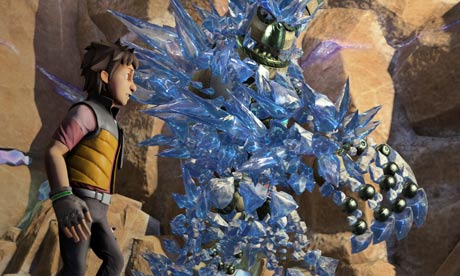 Knack: cool characters
Knack is that rarest of items at the launch of a new console – an
all-new series that promises originality. It's a quirky third-person
action-adventure game, clearly designed to appeal more to the young than
to hardcore gamers. You play Knack, an odd-looking, vaguely robotic
glass character with the ability to surround himself (using a
force-field) with a cloud of detritus picked up from his surroundings,
and thereby to grow in size and change shape.
Knack: cool characters
Knack is that rarest of items at the launch of a new console – an
all-new series that promises originality. It's a quirky third-person
action-adventure game, clearly designed to appeal more to the young than
to hardcore gamers. You play Knack, an odd-looking, vaguely robotic
glass character with the ability to surround himself (using a
force-field) with a cloud of detritus picked up from his surroundings,
and thereby to grow in size and change shape.The demo we played showed that Knack majors on simplicity as far as gameplay is concerned – Knack can attack, jump and dodge, and that's just about it. He progresses along a single path, taking out enemies and solving mainly environmental puzzles. For example, he can denude himself of his forcefield of junk-shards and walk unaffected through laser-fields (since he's made of glass).
 There were hidden areas he could smash open, collecting components
that could be made into helpful items – such as one that harvests energy
from enemies that could be used for special attacks. While there were
some cute touches – in an ice level, for example, Knack assembles a body
made of ice – the gameplay on offer in the demo was a tad repetitive
and not particularly challenging. Although difficulty levels did ramp up
somewhat towards the end of the demo when, thanks to relics he
discovered, Knack had grown to about 30 feet in height, acquiring the
ability to pick up and throw cars at equally giant (and heavily armed)
enemies.
There were hidden areas he could smash open, collecting components
that could be made into helpful items – such as one that harvests energy
from enemies that could be used for special attacks. While there were
some cute touches – in an ice level, for example, Knack assembles a body
made of ice – the gameplay on offer in the demo was a tad repetitive
and not particularly challenging. Although difficulty levels did ramp up
somewhat towards the end of the demo when, thanks to relics he
discovered, Knack had grown to about 30 feet in height, acquiring the
ability to pick up and throw cars at equally giant (and heavily armed)
enemies.Knack was certainly quirky. But graphically, it didn't give the impression of anything more than scratching the surface of the PS4's abilities. Whether its component-assembly engine will allow its gameplay to mutate and progress remains to be seen – a more extended play will be required before we decide whether or not it is likely to be an essential PS4 purchase.
InFamous: Second Son
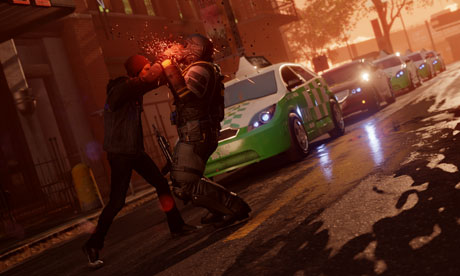 InFamous: Second Son: cult appeal
Sony's InFamous third-person superpower-themed action-adventure
franchise is reminiscent of Killzone, in that its following is more cult
than mainstream. But from what we could see at E3, it looks set to
acquire a PS4-powered makeover that could elevate it to new heights. But
there's bad news – it won't be available until early 2014.
InFamous: Second Son: cult appeal
Sony's InFamous third-person superpower-themed action-adventure
franchise is reminiscent of Killzone, in that its following is more cult
than mainstream. But from what we could see at E3, it looks set to
acquire a PS4-powered makeover that could elevate it to new heights. But
there's bad news – it won't be available until early 2014.And we didn't actually get hands-on with it at E3 – frustratingly having to sit next to one of its developers, who was at least playing it live. It had loads more personality than its predecessors, however, and was very impressive visually.
 Second Son puts you in control of Delsin Rowe, a 24-year-old slacker
just discovering his superhero powers. It's set seven years after
InFamous 2, in a world made nervous by the events chronicled in that
game – the outbreak of a significant chunk of the population discovering
their superpowers has wrecked part of America, and the Department of
Unified Protection has been set up to rein in the superheroes and
villains, and safeguard the ordinary folk. The action takes place in a
meticulous rendering of Seattle – the demo we saw involved taking out a
DUP outpost in the grounds of the Space Needle, and contained a good
deal of virtual rain.
Second Son puts you in control of Delsin Rowe, a 24-year-old slacker
just discovering his superhero powers. It's set seven years after
InFamous 2, in a world made nervous by the events chronicled in that
game – the outbreak of a significant chunk of the population discovering
their superpowers has wrecked part of America, and the Department of
Unified Protection has been set up to rein in the superheroes and
villains, and safeguard the ordinary folk. The action takes place in a
meticulous rendering of Seattle – the demo we saw involved taking out a
DUP outpost in the grounds of the Space Needle, and contained a good
deal of virtual rain.Delsin's superpower is that he can take powers from others, so he can support several sets of superpowers. But when we saw him, he was imbued with a smoke-based superpower, which gave him some incredible moves (and gave a good idea of how the PS4 will be at particle effects). He could fire charges from his hands, do jetpack-style mini-hovers and send out charged-up grenade-style attacks. Plus he can waft into vents and out of the other end of the pipes they lead into. He has a particularly handy-looking dash-attack, and the demo ended with a spectacular, environment-flattening attack in which he soared into the air, then dive-bombed down, causing a massive explosion.
 InFamous: Second Son was perhaps the most compelling of Sony's PS4
launch-window games: it looked inventive and visually spectacular. It's
exactly the sort of game that you need in order to justify the purchase
of a newly launched console, in fact.
InFamous: Second Son was perhaps the most compelling of Sony's PS4
launch-window games: it looked inventive and visually spectacular. It's
exactly the sort of game that you need in order to justify the purchase
of a newly launched console, in fact.The Playroom
The final item of PS4 software that we played was an intriguing item called The Playroom – although Sony points out that it will probably come out under another name, if indeed it comes out. It was a collection of apps created by Sony's Japan Studio, designed expressly to show how the PS4's camera and the controller's Motion Bar interact. It may well end up being bundled with the PS4, although Sony hasn't yet decided whether or not to do that.The first Playroom app was called Controller Checkup, and it was simply a tour around the Dual Shock 4, highlighting the double motors – which, Sony says, can create a sensation of weight by operating asymmetrically, the motion-sensing and the built-in speaker. Next up was Play With Asobi: rubbing the touchpad, as if it was a genie-producing lamp, caused a floating robot to appear, with whom you could interact against a backdrop of the PS4 camera shot of the player. You could bat him away, tickle him and so on. If you annoyed him, he would set your hair on fire or encase your head in virtual ice. Basic stuff, but cute, and it proved that the PS4 camera can do some pretty sophisticated body and facial recognition, plus precise motion-detection.
The next app was called AR Bots. It began by showing what purported to be the area in the controller beneath the touch-pad – full of tiny robots. You could make them fall over by tilting the conveyor, or open up chinks of light by pressing the buttons – to which they responded with little dance moves. Then you could zoom out to the camera shot of you sitting in front of the PS4, and flip them out of the controller by running your finger across the touch-pad. You could then interact with them by moving your body, or even throw them virtual toys which you could create using an Android app on a tablet. Cute again, but not the sort of thing you'd spend hours playing.
Finally, the Playroom package included a take on the classic game Air Hockey, with two players moving their puck-hitters up and down with their touch-pads, and warping the play area by tilting the controller.
The Playroom was quite rough and ready, and was little more than tech-demos, but it did show how developers can use the PS4 camera in tandem with the Dual Shock 4 – which, compared to its predecessors is a box of tricks – to generate some pretty unconventional gameplay, which even approaches the sort of things the Xbox One will be able to do via Kinect.
source :http://www.guardian.co.uk










0 comments:
Post a Comment